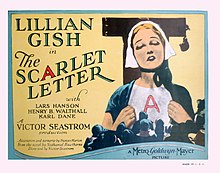The Scarlet Letter (1926 film)
| The Scarlet Letter | |
|---|---|
 Lobby card | |
| Directed by | Victor Seastrom |
| Written by | Frances Marion |
| Based on | The Scarlet Letter 1850 novel by Nathaniel Hawthorne |
| Produced by | Victor Seastrom |
| Starring | Lillian Gish Lars Hanson |
| Cinematography | Hendrik Sartov |
| Edited by | Hugh Wynn |
| Music by | William Axt (uncredited) David Mendoza (uncredited) |
| Distributed by | Metro-Goldwyn-Mayer |
Release date |
|
Running time | 115 minutes |
| Country | United States |
| Language | Silent with English intertitles |
The Scarlet Letter is a 1926 American silent drama film based on the 1850 novel of the same name by Nathaniel Hawthorne and directed by Swedish filmmaker Victor Sjöström (credited as Victor Seastrom).[1] Prints of the film survive in the MGM/United Artists film archives and the UCLA Film and Television Archive.[2] The film is now considered the best film adaptation of Hawthorne's novel.[3]
Cast
[edit]- Lillian Gish as Hester Prynne
- Lars Hanson as The Reverend Arthur Dimmesdale
- Henry B. Walthall as Roger Chillingworth (credited as playing Roger Prynne)
- Karl Dane as Master Giles
- William H. Tooker as The Governor
- Marcelle Corday as Mistress Hibbins
- Fred Herzog as The Jailer
- Jules Cowles as The Beadle
- Mary Hawes as Patience
- Joyce Coad as Pearl
- James A. Marcus as A Sea Captain
- Nora Cecil as Townswoman (uncredited)
- Iron Eyes Cody as Young Native American at Dunking (uncredited)
- Dorothy Gray as Child (uncredited)
- Margaret Mann as Townswoman (uncredited)
- Polly Moran as Jeering Townswoman (uncredited)
- Chief Yowlachie as Native American (uncredited)
- May Boley as Jeering Townswoman (uncredited)
Production
[edit]“Early in the film Gish, as Prynne, loses her bonnet chasing a songbird through a summer glade. When the wind catches her waist-long tresses, Gish appears for an instant as if she had stepped into a painting by Botticelli...Seastrom seizes on Gish's sensuality throughout the film...bringing this largely faithful adaptation down squarely on the side of love and ardent sensuality.”— Film critic Paul Malcolm[4]
The film was the second one Gish made under her contract with M-G-M and a departure from the ingénue roles she had performed in service to director D.W. Griffith. (Her first M-G-M picture was directed by King Vidor, an adaption of La bohème with co-star John Gilbert, in which she played the pathetic consumptive Mimi.)[5] She asked production manager Louis B. Mayer specifically to make The Scarlet Letter: his agreement was reluctant, due to M-G-M's concern that censors would object to a frank depiction of Nathaniel Hawthorne's character, Hester Prynne, whose romantic indiscretions unleash a wave of reactionary bigotry. Director Seastrom disabused these expectations with an opening intertitle "establishing Prynne's [Gish's] ordeal as 'a story of bigotry uncurbed.'"[6]
Shooting took under two months. The production cost a total of $417,000 when factoring out $48,000 overhead costs.[7]
Reception
[edit]The film made a profit of $296,000.[8]
The film is recognized by American Film Institute in these lists:
- 2002: AFI's 100 Years...100 Passions – Nominated[9]
- 2003: AFI's 100 Years...100 Heroes & Villains:
- Hester Prynne – Nominated Hero[10]
See also
[edit]Footnotes
[edit]- ^ "AllMovie's review of The Scarlet Letter (1926)".
- ^ "Progressive Silent Film List: The Scarlet Letter". Silent Era. Retrieved April 10, 2009.
- ^ Miller, Frank (November 25, 2002). "The Scarlet Letter (1926)". Turner Classic Movies. Turner Classic Movies, Inc. Retrieved September 21, 2021.
- ^ Malcolm, 2004
- ^ Durgnat and Simmons, 1988: p. 75-76: In both films Gish plays "the self-sacrificial lover..."
- ^ Malcolm, 2004: "Gish was the project's prime mover as she sought more mature roles after playing ingenues for D. W. Griffith." And: "...Gish's wholesome reputation [established under her D.W. Griffith films] put censorship groups at ease [anticipating] a most chaste Hester Prynne." expected from Gish. And: An opening intertitle reads "a story of bigotry uncurbed."
- ^ Slide, Anthony. "Those Elusive Budget Figures". Silent Topics: Essays on Undocumented Areas of Silent Film. Scarecrow Press, 2005, p. 25.
- ^ Scott Eyman, Lion of Hollywood: The Life and Legend of Louis B. Mayer, Robson, 2005 p 125
- ^ "AFI's 100 Years...100 Passions Nominees" (PDF). Retrieved August 19, 2016.
- ^ "AFI's 100 Years...100 Heroes & Villains Nominees" (PDF). Retrieved August 19, 2016.
References
[edit]- Durgnat, Raymond and Simmon, Scott. 1988. King Vidor, American. University of California Press, Berkeley. ISBN 0-520-05798-8
- Malcolm, Paul. 2004. The Scarlet Letter, 1926. UCLA Film and Television Archive: 12th Festival of Preservation, July 22-August 21, 2004. Guest festival guide.
External links
[edit]- 1926 films
- 1926 drama films
- 1920s American films
- 1920s English-language films
- American black-and-white films
- American silent feature films
- Films based on The Scarlet Letter
- Films directed by Victor Sjöström
- Films scored by William Axt
- Films with screenplays by Frances Marion
- Metro-Goldwyn-Mayer films
- Silent American drama films
- Surviving American silent films
